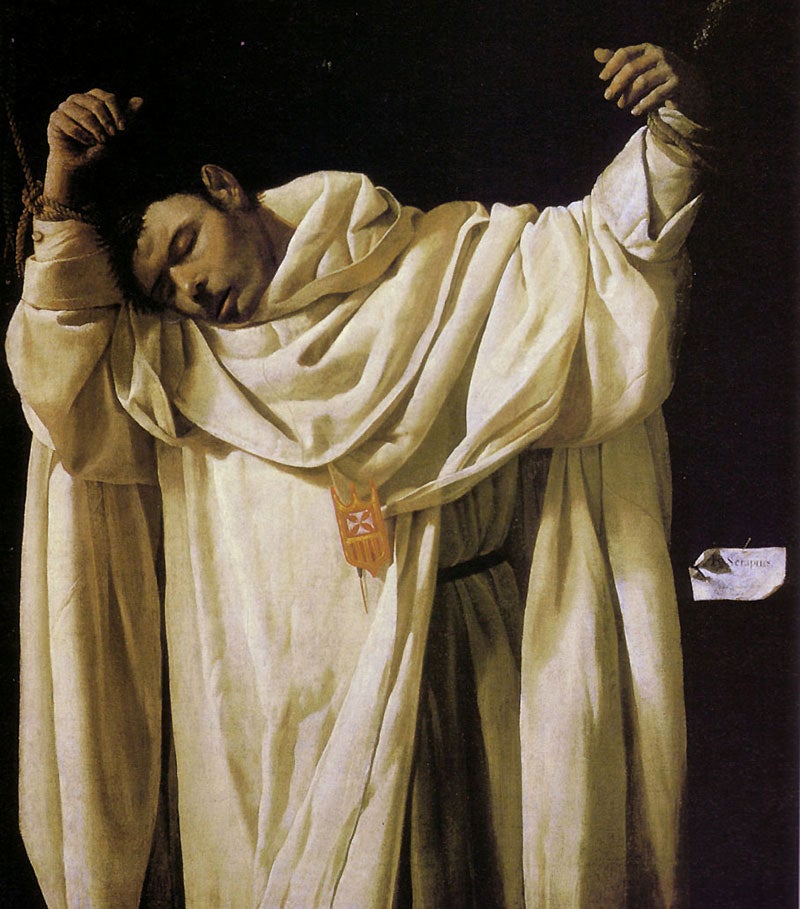de Zurbaran, Francisco: Saint Serapion (1628)
The Independent's Great Art series

The English Jesuit priest Edmund Campion was executed in London in December 1581. Standing on the scaffold with the noose round his neck, he began to speak: "Spectaculum facti sumus Deo, angelis et hominibus". These are the words of St Paul, Englished thus: "We are made a spectacle unto God, unto his angels and unto men, verified this day in me, who am here a spectacle unto my Lord God, a spectacle unto his angels and unto you men..." At this point he was cut short.
Nowadays, sporting events are almost the only occasions when we can enjoy physical endurance as a spectacle. In the days of public executions, the repertoire was wider. When the Catholic Campion was condemned for plotting against Queen Elizabeth, his hanging, drawing and quartering was a show – justice being seen to be done.
But more than that, as Campion's speech makes clear, it was a show in which both the authorities and the victim had an interest. From one point of view, here was a heretic-traitor, receiving his due and horrible destruction. From the other, here was a martyr, bearing witness to the end. The spectacle of punishment and the spectacle of enduring faith are one.
Serapion was another British martyr. Medieval, half-legendary, he's supposed to have gone to Spain to fight the Moors, and become a friar in the Order of Mercy, and ended up butchered in Algeria – tied to a diagonal cross, broken, disembowelled, beheaded, undergoing something like a full-dress European penal execution.
What makes Francisco de Zurbaran's Saint Serapion so striking is its extreme non-violence. It eschews both blood and suffering. The friar's white habit is spotlessly laundered. The man himself is unconscious, his head and body are slumped – dead, knocked out, fainted, exhausted, you can't say, but not conspicuously harmed. The only hint of a wound is metaphorical: the opening of the outer robes to reveal a glimpse of the body within.
The main sign of a public execution is the dramatic way he is strung up and put on show. His bonds hold his limp body frontally to the picture's view. His quasi-crucified pose fills the picture's space. Behind the blazing figure, the background is dark, and there's some woodwork to be obscurely discerned. But the main impression is that the victim's wrists are roped to the very corners of the picture's frame. He is stretched out on the canvas's stretcher.
So, you might say that the painting we're looking at is itself an instrument of torture. The spectacle of Serapion's martyrdom is equated with his display in this scene. Death by picturing! But this device isn't, as it might be, a means of pumping up the cruelty of the subject, pushing it in the viewer's face. The passivity of the martyr's body prevents that. The sides of the picture from which he hangs become not restraints but supports, holding him up from falling.
The way the picture stops at his knee-level makes you less conscious of the body's weight, its pull towards the ground, the strain the arms are under. Meanwhile, the side-flopped head turns the figure into an oblong, as if it was entirely a sheet of cloth. Serapion hangs gently in folds, like a beautiful piece of washing on a line.
The picture wishes him rest. It is not so much his scaffold, more his cradle. (You can see his pose as sleeping as well as hanging.) Unlike most martyr-paintings, unlike Campion on the scaffold, Saint Serapion doesn't offer a spectacle of upstanding, heroic martyrdom, a show-off drama of ferocious brutality and magnificent endurance. It omits the exciting facts of violation. It displays the victim, makes him so emphatically visible, simply for our mercy.
The artist
Francisco de Zurbaran (1598-1664) painted the light of God. The Spanish artist worked mainly for churches and monasteries, doing images of saints and martyrs, visions and crucifixions. Inspired by the lighting of Caravaggio, he devised a series of minimal but stunning dramas of visibility. A typical image: a standing figure, in monastic robes, stands out against darkness, in a sentry-box frame – caught in a shaft of light, made visible to the Christian viewer and to the eye of God, standing on duty. Still-life elements may be emphasised, too: a book, a loaf, a vessel, a basket. Occasionally they have a picture to themselves, and are imbued with a sacramental feeling.
Join our commenting forum
Join thought-provoking conversations, follow other Independent readers and see their replies
Comments
Bookmark popover
Removed from bookmarks